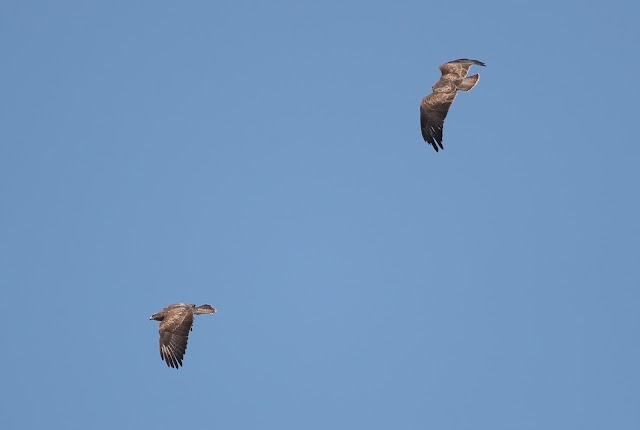It's hard to believe that just 3 weeks ago I with Chris and Tony were enjoying the birds, scenery and hospitality of the people of Extremadura, Spain. Such lovely people and beautiful country now ravaged in such a short time by this terrible virus that is Covid-19.
We were based at Trujillo for 4 nights, so within minutes of leaving our hotel we were in the plains.
Trujillo Bull Ring one of the best and easiest places to see Lesser Kestrels
Lesser Kestrel Beautiful against the bright blue sky, unfortunately most of the time it was overcast with some drizzle and always windy.
Lesser Kestrel
A purpose built hide over looking Lesser Kestrel nest sites
A poor long range image which contains 12 Great Bustards. Most of the Bustards we saw were quite distant but some showed very nicely.
Great Bustards
Great Bustard
Great Bustard
Great Bustard against a leaden sky
All the Little Bustards we saw were distant and seemed skittish even at at a distance. Although quite drab on the ground in flight they were very striking.
Little Bustards
Little Bustards
Little Bustards
The Calandra Lark was probably my favourite bird of the Plains, there were huge numbers of them all over and a delight to see and hear. It is probably only on the Steppes of Kazakstan that I have seen more Calandra Larks.
Calandra Lark a joy to see and hear
Calandra Lark
Calandra Lark
Calandra Lark
Corn Buntings were abundant
Crested Larks were also abundant
Many large flocks of Spanish Sparrows were seen
Stone Curlews flushed by a tractor
Stone Curlew
We saw saw several Hen Harriers, all were males!
Several Black Winged Stilts were found on small pools along with other waders
White Stork was another common species seen
Iberian Grey Shrikes were fairly common
We only saw a few Common Cranes in Extremadura as most had migrated North, though we did see 1,000s near Madrid migrating.
In the damp areas we found some Red Avadavats, which as soon as the flocks landed in the fields or reeds they vanished. A few Bluethroats and Great Spotted Cuckoo's were seen, as were the ever present Vultures including a fairly early Egyptian Vulture but we were a little early for most of the spring migrants. My thanks to Chris and Tony for making it such an enjoyable holiday, I'm sure I will return another year perhaps in mid to late April.





















































